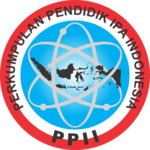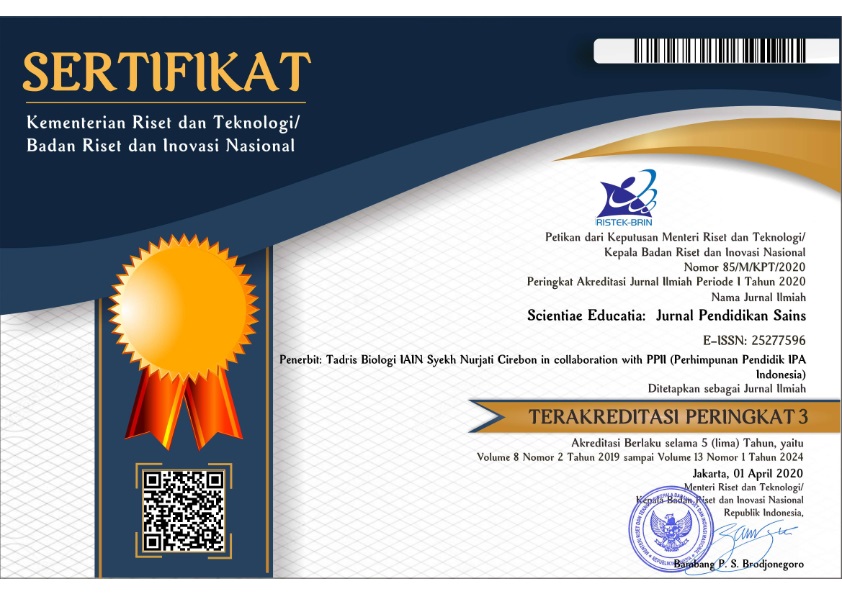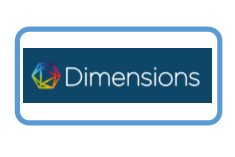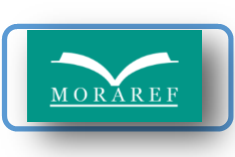Developing BTEM-Based Virtual Biology Laboratory to Improve Students' Critical Thinking Skills on the Concept of Bacteria
(1) Department of Biology Education, Faculty of Teaching and Educational Sciences, Universitas Majalengka
(2) Department of Biology Education, Faculty of Teaching and Educational Sciences, Universitas Majalengka
(*) Corresponding Author
Abstract
The Covid-19 pandemic that has hit the entire world has caused changes in learning patterns from classroom to virtual classroom activities, and this has caused biology teachers to experience problems when teaching material through direct practicum activities. There is a need for solutions that can facilitate practicum activities by developing a virtual laboratory application. This research develops a Virtual Biology Laboratory (VLab-Bio) application based on Biology, Technology, Engineering, and Mathematics (BTEM) that is feasible and practical to facilitate virtual lab work on the concept of bacteria. The application product produced from this research is expected to help students facilitate practicum activities and improve critical thinking skills on the concept of bacteria. The application produced from this research is expected to help students improve their critical-thinking skills and lab work on bacterial material. Akker development model was used with four stages of development: preliminary research, prototyping, summative evaluation, and systematic reflection and documentation. The research instrument consisted of tests of critical-thinking skills and non-tests in the form of observations of the learning process and student response questionnaires. The research data were analyzed qualitatively and quantitatively with the paired t-test. The results showed that the BTEM-based virtual laboratory developed was classified as valid and effective in improving students’ critical-thinking skills with 78% effectiveness. Based on this research, it can be recommended that using a BTEM-based virtual laboratory can be used as a supplement in facilitating bacterial concept practicum activities. For further application development, it is hoped that the application can provide flexibility for students to develop their own practicum procedures in applications.
Keywords
Full Text:
PDFReferences
Akker, J. V. D., Gravemeijer, K., McKenney, S., & Nieveen, N. (2009). Educational design research. Routledge.
Alneyadi, S. S. (2019). Virtual lab implementation in science literacy: Emirati science teachers’ perspectives. Eurasia Journal of Mathematics, Science and Technology Education, 15(12), 1-10.
Bajpai, M., & Kumar, A. (2015). Effect of the virtual laboratory on students' conceptual achievement in physics. International Journal of Current Research, 7(02), 12808–12813.
Cheong, K. H., & Koh, J. M. (2018). Integrated virtual laboratory in engineering mathematics education: Fourier theory. IEEE Access, 6, 58231–58243.
De Jong, T., & Van Joolingen, W. R. (1998). Scientific discovery learning with computer simulations of conceptual domains. Review of educational research, 68(2), 179-201.
Dewi, E. R. S., & Prasetiyo. (2015). Penerapan media virtual laboratorium dalam pembelajaran biologi materi eubacteria terhadap hasil belajar dan karakter siswa. Bioma, 4(1), 69–79.
Dyrberg, N. R., Treusch, A. H., & Wiegand, C. (2017). Virtual laboratories in science education: students’ motivation and experiences in two tertiary biology courses. Journal of Biological Education, 51(4), 358–374.
Flowers, L. O. (2011). Investigating the effectiveness of virtual laboratories in an undergraduate biology course. The Journal of Human Resource and Adult Learning, 7(2), 110.
Gunawan, & Liliasari. (2012). Model virtual laboratory fisika modern untuk meningkatkan disposisi berpikir kritis calon guru. Cakrawala Pendidikan, 31(2), 185–199.
Gunawan, A. Harjono, H. Sahidu, L. H. (2017). Virtual laboratory of electricity concept to improve prospective physics teachers creativity. Jurnal Pendidikan Fisika Indonesia, 13(2), 102–111.
Halpern, D. F. (2014). Thought and knowledge: An introduction to critical thinking (5th ed.). Psychology Press.
Hiong, L. C., & Osman, K. (2013). A conceptual framework for the integration of 21st-century skills in biology education. Research Journal of Applied Sciences, Engineering, and Technology, 6(16), 2976–2983.
Hiong, L. C., & Osman, K. (2015). An interdisciplinary approach for biology, technology, engineering, and mathematics (BTEM) to enhance 21st century skills in Malaysia. K-12 STEM Education, 1(3), 137–147.
Jaya, H. (2013). Pengembangan laboratorium virtual untuk kegiatan paraktikum dan memfasilitasi pendidikan karakter di SMK. Jurnal Pendidikan Vokasi, 2(1), 81–90.
Malik, A., Novita, Y., & Nuryantini, A. Y. (2019). Enhancing critical thinking skills of students related to temperature and heat topics through problem-solving- laboratory model. Jurnal Penelitian & Pengembangan Pendidikan Fisika, 5(1), 9–20.
Moeti, B., Mgawi, R. K., & Moalosi, W. T. S. (2017). Critical Thinking among Post-Graduate Diploma in Education Students in Higher Education: Reality or Fuss?. Journal of Education and Learning, 6(2), 13-24.
Muhamad, M., Zaman, H. B., & Ahmad, A. (2012). Virtual biology laboratory (VLab-Bio): Scenario-based learning approach. Procedia-Social and Behavioral Sciences, 69, 162-168.
NRC. (2009). A new biology for the 21st Century: Ensuring the United States leads the coming biology revolution. National Academies Press.
Osman, K., Hiong, L. C., & Vebrianto, R. (2013). 21st Century biology: An interdisciplinary approach of biology, technology, engineering, and mathematics education. Procedia-Social and Behavioral Sciences, 102, 188-194.
Ramadhan, M. F. (2017). Using virtual labs to enhance students ’ thinking abilities, skills, and scientific attitudes. Iceri, 494–499.
Rustaman, N. Y., Dirdjosoemarto, S., Yudianto, S. A., Kusumastuti, M. N., Rochintaniawati, D., & Achmad, Y. (2003). Stategi belajar mengajar biologi. UM Press.
Sapriadil, S., Setiawan, A., Suhandi, A., Malik, A., Safitri, D., Lisdiani, S. A. S., & Hermita, N. (2019). Effect of higher-order thinking virtual laboratory (HOTVL) in the electric circuit on students' creative thinking skills. Journal of Physics: Conference Series, 1204(1).
Setiawan, A., Malik, A., Suhandi, A., & Permanasari, A. (2018, February). Effect of higher-order thinking laboratory on the improvement of critical and creative thinking skills. In IOP Conference Series: Materials Science and Engineering (Vol. 306, No. 1, pp. 1-7). IOP Publishing.
Stuckey-Mickell, T., & Stuckey-Danner, B. (2007). Virtual labs in the online biology course: Student perceptions of effectiveness and usability. MERLOT Journal of Online Learning and Teaching, 3(2), 105–111.
Suryaningsih, Y., Gaffar, A. A., & Sugandi, M. K. (2020). pengembangan media pembelajaran praktikum virtual berbasis android untuk meningkatkan berpikir kreatif siswa. BIO EDUCATIO : (The Journal of Science and Biology Education), 5(1), 74–82.
Suryanti, E., Fitriani, A., Redjeki, S., & Riandi, R. (2019, October). Virtual laboratory as a media to improve the conceptual mastery of molecular biology. In Journal of Physics: Conference Series (Vol. 1317, No. 1, p. 012202). IOP Publishing.
Sutarno, S., Setiawan, A., Suhandi, A., Kaniawati, I., & Hamdani, D. (2018). Model higher order thinking virtual laboratory: model praktikum fisika berbasis keterampilan berpikir kritis dan pemecahan masalah secara kreatif. Jurnal Pendidikan Eksakta, 3(5), 189-193.
Syah, M. (2011). Psikologi belajar. Raja Presindo Persada.
Sypsas, A., & Kalles, D. (2018, November). Virtual laboratories in biology, biotechnology, and chemistry education: a literature review. In Proceedings of the 22nd Pan-Hellenic Conference on Informatics (pp. 70-75).
Tatli, Z., & Ayas, A. (2010). Virtual laboratory applications in chemistry education. Procedia-Social and behavioral sciences, 9,
-942.
Toth, E. E., Ludvico, L. R., & Morrow, B. L. (2014). Blended inquiry with hands-on and virtual laboratories: the role of perceptual features during knowledge construction. Interactive Learning Environments, 22(5), 614–630.
Tüysüz, C. (2010). The effect of the virtual laboratory on students’ achievement and attitude in chemistry. International Online Journal of Educational Sciences, 2(1), 37–53.
Widodo, A., Maria, R. A., & Fitriani, A. (2017). Constructivist learning environment during virtual and real laboratory activities. Biosaintifika: Journal of Biology & Biology Education, 9(1), 11-18.
Widowati, A., Nurohman, S., & Setyowarno, D. (2017). Development of inquiry-based science virtual laboratory for improving student thinking skills of junior high school. Jurnal Pendidikan Matematika Dan Sains, 5(2), 170–177.
Woodfield, B. (2005). Virtual Chemlab getting started. Pearson Education.
Zion, M., Shapira, D., Slezak, M., Link, E., Bashan, N., Brumer, M., Orian, T., Nussinovitch, R., Agrest, B., & Mendelovici, R. (2004). Biomind - A new biology curriculum that enables authentic inquiry learning. Journal of Biological Education, 38(2), 59–67.
Zubaidah, S. (2019). Pendidikan biologi dalam perkembangan revolusi industri. In Seminar Nasional Pendidikan Biologi dengan Tema “Biologi di Era Revolusi Industri 4.0: Riset dan Pembelajaran†di FKIP Univesitas Negeri Jakarta, 17 September 2019, (pp. 1–22).
DOI: 10.24235/sc.educatia.v9i2.7379
Article Metrics
Abstract view : 1 timesPDF - 0 times
Refbacks
- There are currently no refbacks.
Scientiae Educatia: Jurnal Pendidikan Sains indexed by:

This work is licensed under a Creative Commons Attribution 4.0 International License.
Stat Counter (Link)



1.png)












